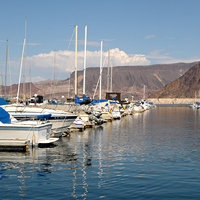Note: Marlinspike is a nautical term that refers to a sharp, six to 12 inch metal pin, usually made of iron or steel, that’s used to splice rope, untie knots, or form toggles or handles. Skippers, mates and deckhands that become proficient with the marlinspike can be referred to as Marlin Spikes or Marlin Spike Seamen.
Boating is a technical undertaking. Whether maneuvering a sailboat or powerboat into or out of its berth, piloting or navigating, or repairing and maintaining electrical and plumbing systems, it requires technical know-how. My grandfather, who was a Navy officer, and father taught me that while I needn’t do everything myself, I should know how to do everything so I can ensure that what is done for me is done properly. Marlinspike seamanship is among the technical specialties you need to know, and it includes more than knots and splices.
1. Fiber rope consists of fibers formed into yarns, strands, braids or plaits. Three-strand rope consists of fibers twisted to form right-hand yarns, which are twisted in the opposite direction into strands, then twisted right and into rope. When you hold a length of rope away from you, notice that the strands spiral in a clockwise direction. A closer examination shows that the fibers in the strands are parallel to the length of the rope.
2. To properly coil laid line, hold one end in your left hand, palm up, elbow into your side, with the end hanging below the coil that you’ll be making (so it won’t tangle). Slide your right-hand palm down along the rope, grasp it with thumb and forefinger and, giving it a slight twist away from you to form the coil, lay it in your left hand. Keeping your left elbow fixed and reaching a consistent distance to your right will result in coils of the same diameter as they rest in your left hand. If the line is too long or heavy, lay large-diameter coils on the ground around you; remember to induce that twist. Stabilize large coils of heavy rope with separate light lines tied along the circumference to keep the coils together (try to keep the coils from capsizing). With very long lines — for example, anchor rode — you may need to do this several times. If you need to move the coil to store it, lay the coil into a figure eight. It’s extremely difficult to make a sea gasket with a large coil of heavy line. Loop a length of canvas with grommets at both ends around the coil and hang it in your anchor locker.
3. Why spend so much time on three-strand laid line? Three-strand nylon is the most common and best line for anchor rode. It’s an acceptable compromise between strength and elasticity, and it’s easy to splice or repair. An anchor rode with a closed eye splice around a thimble also should have an eye spliced at the bitter end. Secure that eye to an eyebolt in the anchor locker with multiple turns of light Dacron line (1/8- to 1/4-inch diameter) passed through the bolt and eye (each part reduces the load on that line). It should reach from the eyebolt to the deck. If you ever need to slip your anchor, simply cut one of the parts of the Dacron, which is less elastic than nylon and won’t snap back when cut under stress. One last comment about anchor line: It’s your cheapest insurance. You should have plenty of correctly sized rode on board.
4. Keep in mind that nylon line absorbs water, and this weakens it by about 10 percent. Better nylon line is lubricated to resist water. Also, three-strand nylon, as with any laid line, will twist and kink if handled incorrectly, hence the slight twist and clockwise coiling.
5. Let’s talk mechanical advantage. Every boat, both power and sail, should have a couple of blocks on board to enable the rigging of a block and tackle in an emergency. As a minimum, one block should be a double sheave or a fiddle block (double block) fitted with a swiveling shackle. The second block also should have a swiveling shackle and a becket, a fitting for attaching line to the block. Secure the single block to the load by its shackle and run a line from the becket through a sheave, back to the single block and around the second sheave of the double block. Voila, you have a 3-to-1 advantage. Every pound exerted on the line leading from the double block produces 3 pounds of pull on the single block with its load. Every part of the line leading from the blocks on the load adds a mechanical advantage. It’s slower than hauling a line but less work. Reversing this is faster, but harder; it’s called a “fool’s tackle.”
Article by: Michael Saylor
Soundings Publications LLC
SoundingsPub.com


